From the Sefer
״Inside Sta”m״ by Rabbi Reuvain Mendlowitz, with permission from
the author
From the Sefer
״Inside Sta”m״ by Rabbi Reuvain Mendlowitz, with permission from the author
The “Rashba”
We explained the details of the Rashba’s shittah in question 5. As we
mentioned, if the sofer was not careful to observe the Rashba’s opinion
when writing the tefillin, it is difficult to justify selling such parashiyos as
mehudar.53 Therefore, this rates high on the list of hiddurim.
The “Radach”
There is a halachah known as “chak tochos.” Literally translated, this means to “scrape the insides.” The practical application in terms of Hilchos Sta”m is that a letter
must be created by writing, not through scraping or erasing.54
In other words, should there be a blotch of ink on the klaf, a sofer would not be permitted to merely scrape away part of the ink and thereby create the form of a letter. [Fig 26] The form of the letter must actually be written.
The above assumes that the entire letter was created by means of chak tochos. Would it be permitted to create part of a letter by way of chak tochos while finishing it off by writing the remaining part(s) of the letter?
While most Acharonim.55 are of the opinion that it would indeed be permitted, the Radach (R’ David ben Chaim HaKohen of Corfu, d.1531) insists.56 that the entire letter be created solely through writing.

The classic example of such a case is when the sofer wrote a mem, and the two parts touched at the bottom. [Fig. 27] The mem is now pasul, as in essence it has become a mem sofis (final mem). Should the sofer erase only the left side of the letter [Fig. 28] and rewrite it, the right side of the letter will have been (re)created through chak tochos since it had acquired the new identity of a mem sofis, and only re-acquired its status as a “regular” mem by way of the erasure.
As mentioned above, while most Acharonim permit this, the Radach rules that the STA”M item is now pasul. And since a number of Acharonim rule in accordance with the opinion of the Radach,57 it would be an enhancement of any Sta”m item for the Radach’s chumrah (stringency) to be observed.
Shem HaShem written as in the Zohar
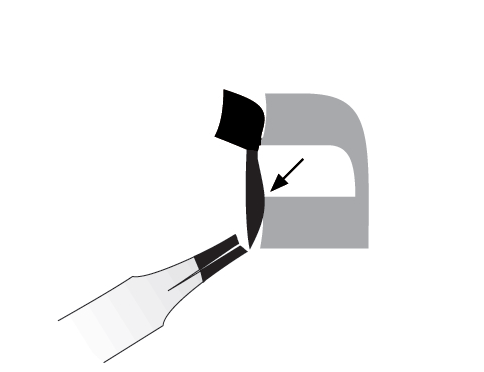
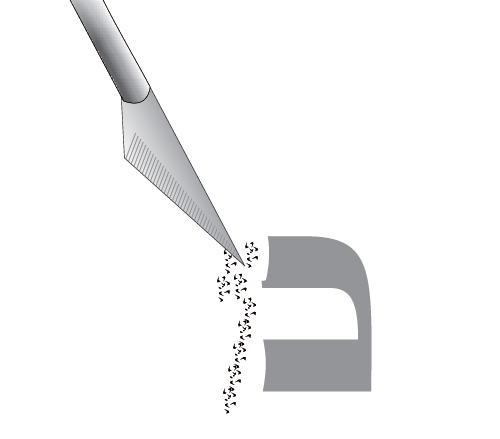

The “Avnei Nezer”
Halachah dictates that tefillin and mezuzos must be written k’sidran (in sequence).203 For instance, when writing the word the first word in a( שמע mezuzah), the sofer must first write the shin, and only then may he proceed to write the mem, and only after completing the mem may he proceed to write the ayin, and so on and so forth until the end of the mezuzah. Tefillin (or a mezuzah) written shelo k’sidran (out of sequence) are pasul. (Sifrei Torah, Nevi’im, and megillos have no such requirement.)204
Often, a sofer finds it helpful to write parts of later letters first. This could happen, for instance, if the sofer approaches the end of a line, and observes that it is going to be a tight squeeze to complete the last word on the line without going into the margin. [Fig. 99] It may therefore be more practical for him to write at least the top part of the letters – from the end of the line working backwards [Fig. 100] – and then finish them off in order. [Fig. 101]
This is called chetzi os shelo k’sidran (half a letter out of sequence). There is a dispute among the Acharonim as to whether or not this practice
is permitted when writing tefillin and mezuzos.205 The Avnei Nezer (R’ Avraham of Sochatchov, 1838–1910) maintains that this would render the tefillin (or mezuzah) pasul.
Contemporary poskim are of the opinion that l’chatchilah one should not rely on the lenient opinions.206 when writing or selling what is supposed to be a mehudar product.207 Therefore, this also ranks high on the list of hiddurim.208
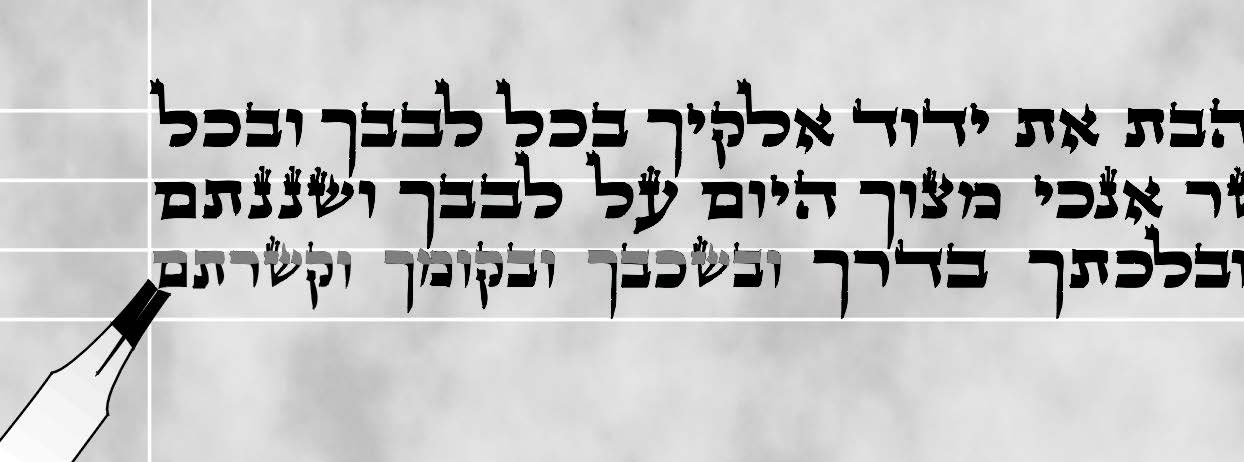
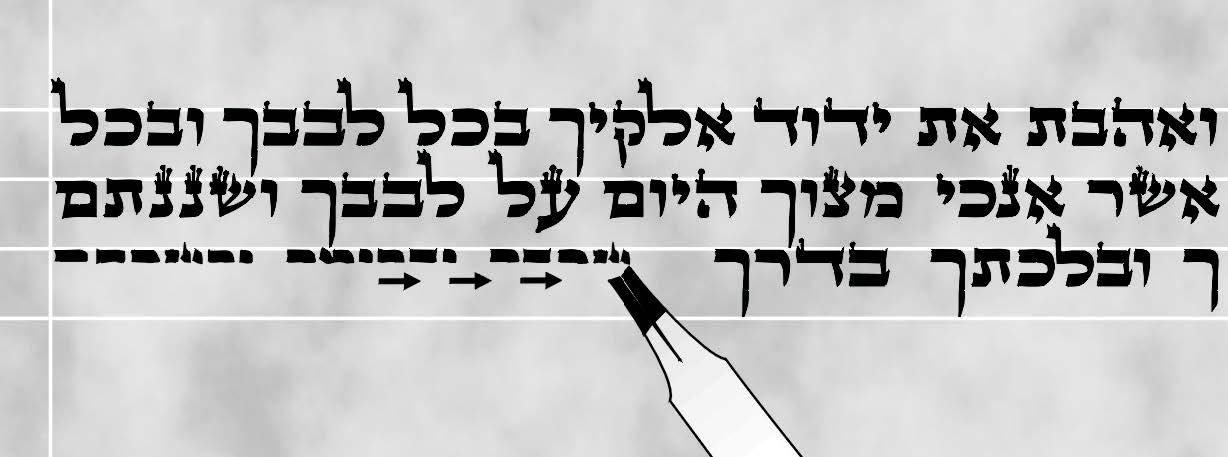
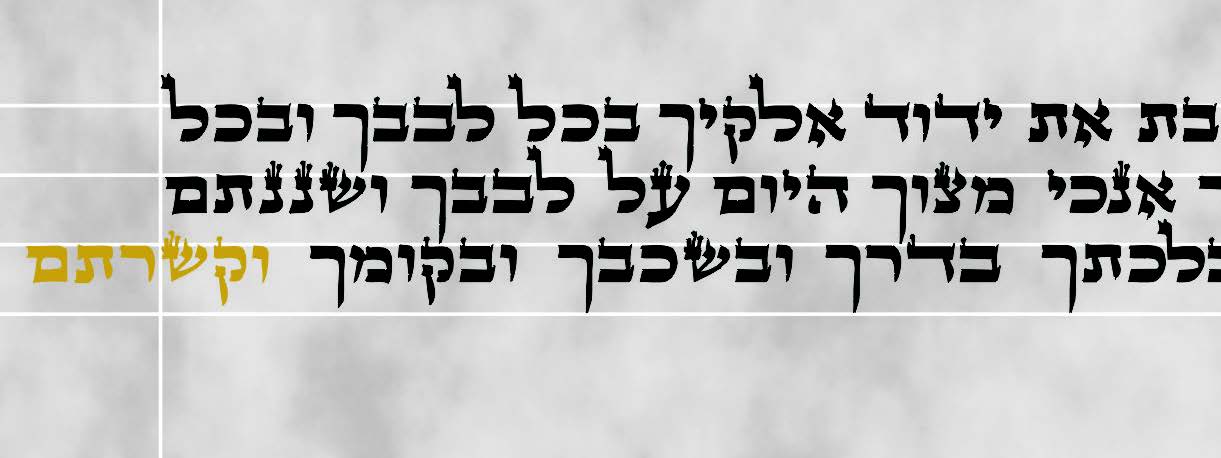
203 סי‘ ל“ב סעי‘ כ“ג.
204 עיין לשכת הסופר סימן ט‘ ס“ק א‘ ד“ה עוד כתב, וע”ע בגליון מהרש”א ריש סי’ רע”ו.
205 הפמ“ג מיקל בזה והעתיקוהו הלשכת הסופר, מקדש מעט, מלאכת שמים והמ“ב בריש קיצור כללי שלא כס־ דרן שנדפס לאחר סי‘ ל“ו; ועיין בשו“ת אבני נזר חאו“ח סי‘ ט‘ – י‘ שהאריך להחמיר בזה וחולק ע“ד הפמ“ג וכן בשו“ת שואל ומשיב )תליתאה סי‘ צ“ו( החמיר בחריפות וכ“כ בספר תפארת ארי‘ להחמיר בזה.
206 כן דעת מרן הגרי“ש אלישיב זצ”ל דצריך לחשוש לדעת האבנ“ז עכ“פ לכתחילה וכ“כ בשו“ת שבט הלוי ח“א סי‘ י“ב )ב(, ח“ו סי‘ ד‘ )ה‘( וח“ז סי‘ קס“ד )ג(; וכן הי‘ דעת הגה“ג רבי ישראל יעקב פישר זצ“ל דצריך לחוש לכתחילה.
207 עיין שו“ת שבט הלוי ח“ז סי‘ קס“ד )ג( דיש לחוש לזה גם ממקח טעות אם הקונה הוא מהמדקדקים.
208 ושמעתי ממו“ר הגאון הרב מרדכי פרידלאנדר שליט“א שהידור זה הוא מ“האל“ף בי“ת של סתו“ם מהודרות“.
Megurad, Lo Megurad
Lo Megorad means not scraped. Let us explain what this is referring to.
When an animal is skinned, we are left with the hide. The hide of a cow is very thick, and is made up of a number of layers:
- The thin outer layer under the hair (the litza – epidermis). [Fig. 43]
“Litza” Epidermis
Dermis Hide - The thick layer be- neath (dermis) that is full of veins, arteries and other fatty substances. [Fig. 44]
- The smooth inner la- yer of the hide. [Fig. 45]
In olden times, the hides would be split in two. [Fig. 46] Sta”m would be written on the inside of the outer layer. [Fig. 47] This is what we call “klaf.” Nowadays, we are not experts in the art of splitt- ing the hide in two. There- fore, we simply scrape away the entire inner layer until we reach that same spot – the inside of the outer layer. [Fig. 48] (The litza is scraped off as well.) Consequently “Klaf”
we are writing Sta”m on the same part of the hide where sofrim always wrote in the past.
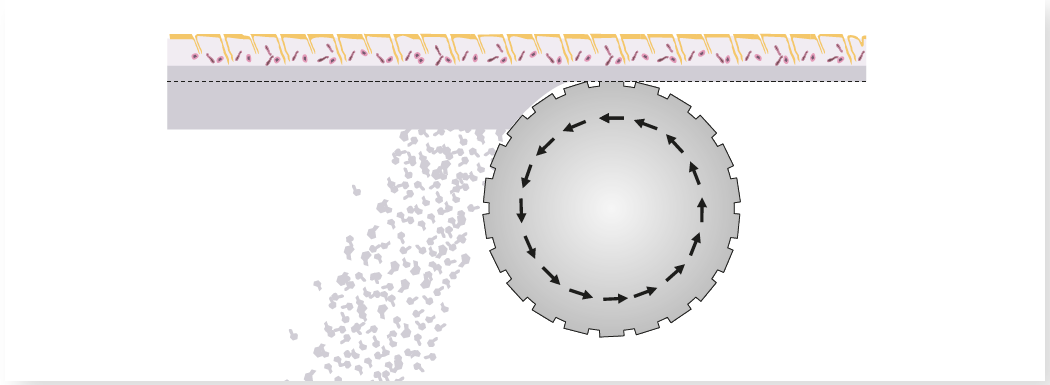
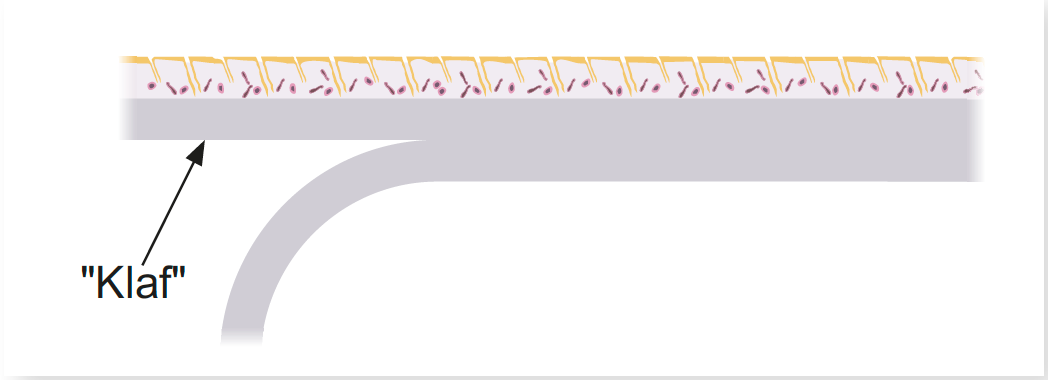
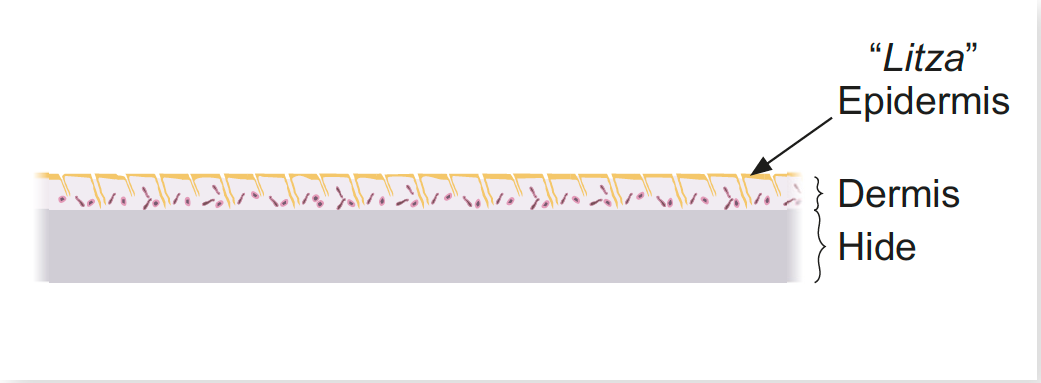
All this is based on the understanding that the outer half of the hide is called klaf, while the inner half of the hide is what Chazal referred to as duchsustus, which may not be written on.
However, the Chayei Adam.111 (R’ Avraham Da- nzig, 1748–1820) did not agree that the outer half is klaf while the inner half is duchsustus. Rather, he maintained that only the outer thin layer is klaf, and only the smooth inner layer is duchsustus. Therefore, the thick, fatty middle layer, having no identity of its own, is associated with whatever it is attached to. [Fig. 49]
Hence, according to the Chayei Adam, if the top, outer thin layer is scraped off [Fig. 50], we no longer have klaf. Ac- cording to the other poskim.112 however, even if the outer thin layer is scraped off, we are still writing on klaf (as long as we are writing on the inside of the outer half).
The definition of klaf “lo megurad,” then, is: klaf which has not had the outer thin layer scraped at all, in accordance with the opinion of the Chayei Adam.113
There are many who are careful to buy only klaf lo megurad (in spite of its additional cost) because all opinions agree that this klaf is mehudar.114
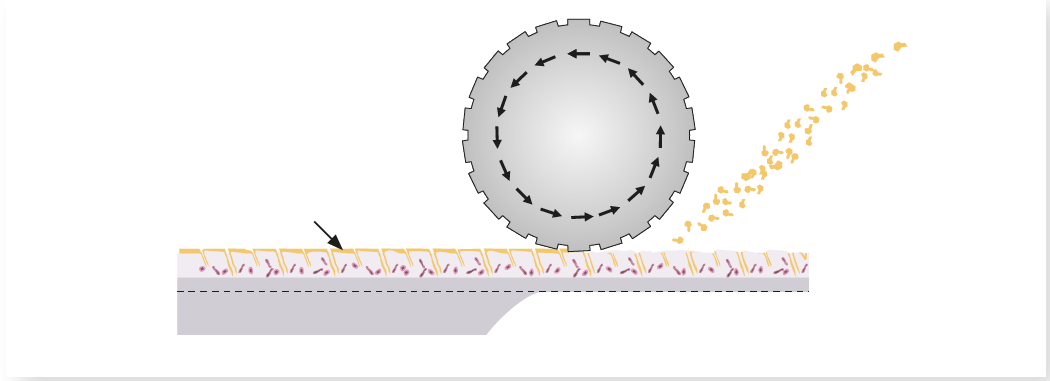
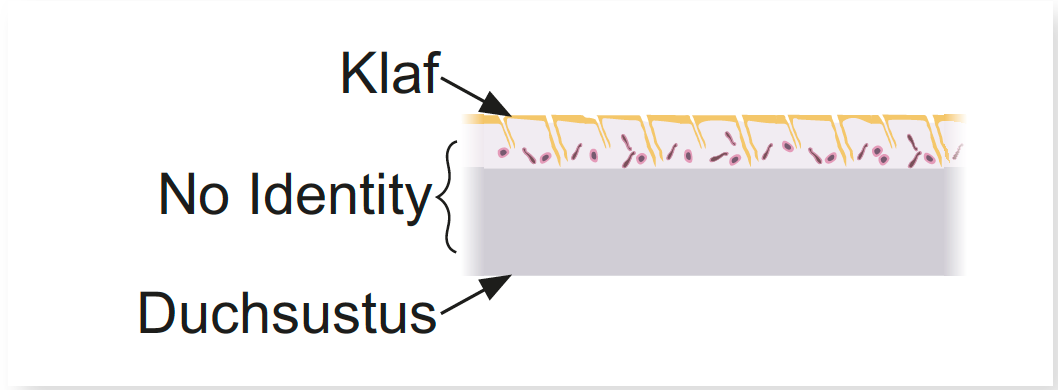
111 ׳כלל י“ד נשמת אדם אות ג‘.
112 שו“ת חתם סופר או“ח סי‘ ג‘; שו“ת חסד לאברהם ח“א סי‘ ד‘.
113 כל מה שכתבתי כאן אינה אלא טיפה מן ים התלמוד בסוגיא זו ואינו נכון בכל פרטיו לכל הדיעות ולכל השיטות בזה, וא“א לפרש הכל בלי קונטרס נפרד. ומי שרוצה לעיין בזה צריך ללמוד כל הענין כדבעי, וע“כ כתבתי רק מה שנוגע לעיקר ההלכה למעשה ובאופן הכי פשוט שאפשר הגם שאינו מוסכם לכל הראשונים והאחרונים.
Avodas Yad
There are two types of klaf on the market: klaf mechonah (machine- made) and klaf avodas yad (handmade).
Let’s try to explain the difference between the two, along with the halachic ramifications.
In order for an animal hide to acquire the halachic status of klaf, it must undergo a process called ibbud. A hide that has not undergone ibbud is called diftera, not klaf.
Sta”m must be written on klaf, and may not be written on diftera.
The ibbud process includes various stages: primarily soaking the hides in various ingredients specified by Chazal.90 Once this has been completed, we now have klaf.
However, there is another essential halachah: The ibbud must be done “lishmah” (with specific intent). If the ibbud was done without the specific.91 (and ideally, verbal.92) consecration that these hides will be used for Sta”m, they are rendered pasul (invalid).
Until the mid-twentieth century, all klaf was avodas yad for the simple reason that there were no machines capable of carrying out the ibbud process. Only with the advent of modern machinery did it become possible to process hides by machine.
Formerly, the ibbud had been done by filling vats with the various ingredients required for the ibbud process, and then stirring the mixture until it became thick. Then the hides were placed in this mixture lishmah, and remained there for about eight to nine days, by which point the hairs had fallen out on their own. Next the skins were removed from the vats, and any remaining hairs were scraped off. The hides were then returned to the vats for an additional three to six days (depending on the size of the skins) to complete the ibbud. Finally, the hides were then cleaned up and used for Sta”m.93
90 במגילה י“ט ע“א מבואר שתחילה מולחים אותו, ואח“כ שורים אותו במים, ואח“כ מעבדים אותו בעפצים, והוא עיקר עיבודו שע“י כך הקלף מתכווץ ומתחזק וממילא נעשה ראוי לכתיבה, וכן נמצא בגיטין כ“ב ע“א רש“י ד“ה לכתוב. ועיין בראש ספר תקון תפילין דכ“כ באריכות. וכתב ר“ת )מנחות ל“א ע“ב בתוס‘ ד“ה הא( דבזמנינו מעבדים בסיד ולא בעפצים. וע“ע במ“ב מהדורת עוז והדר סי‘ ל“ב סעי‘ ח‘ בציונים והערות אות קט“ז. וע“ע
משנת הסופר סי‘ ב‘ ס“ק ל“ד בנוגע לעיבוד עם דברים כימיים (chemicals).
91 עיין מ“ב סי‘ ל“ב ס“ק כ“ו, וקסת הסופר סי‘ ב‘ סוף סעי‘ ד‘. 92 עיין מ“ב ס“ק כ“ד. 93 כ“כ בספר תיקון תפילין לרבינו אברהם ז“ל מזונשהיים עמ‘ לב – לד.
92 עיין מ“ב ס“ק כ“ד.
93 כ“כ בספר תיקון תפילין לרבינו אברהם ז“ל מזונשהיים עמ‘ לב – לד.
